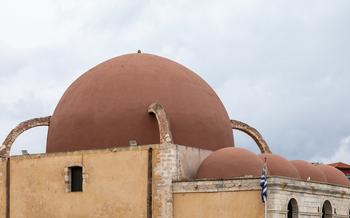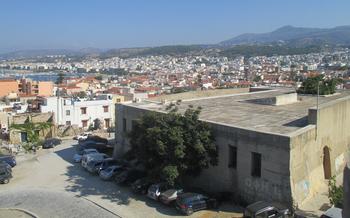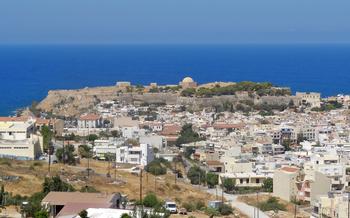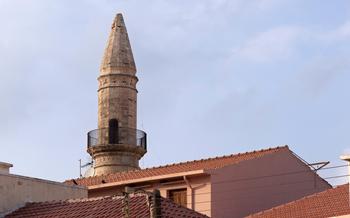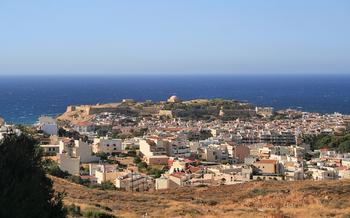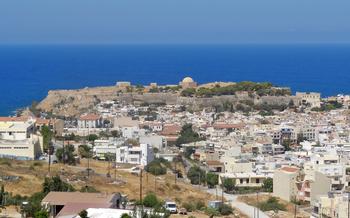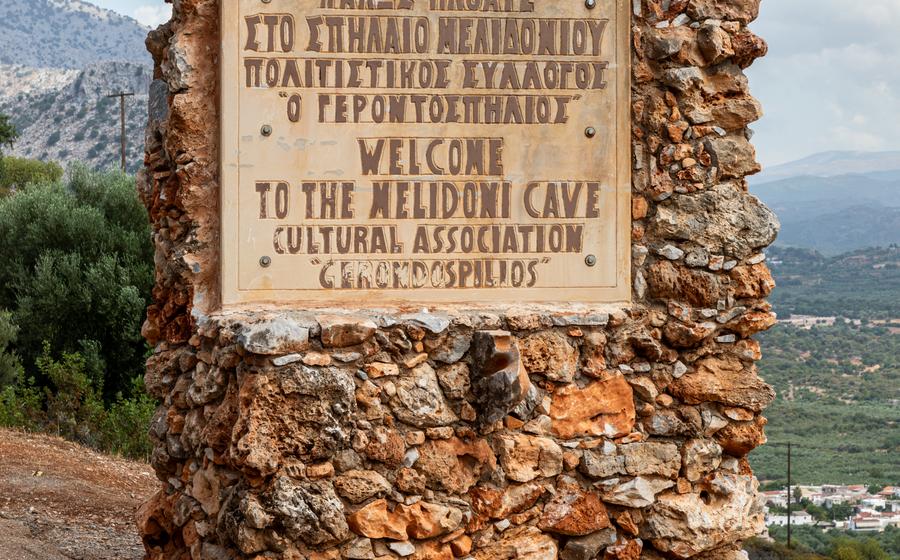
Melidoni Cave
- Melidoni Cave: An Overview
- A Journey Through Time
- Exploring the Cave's Interior
- Marvelous Stalactites and Stalagmites:
- Discovering Hidden Treasures
- A Sanctuary for Wildlife
- Myths and Legends of Melidoni:
- The Cave's Historical Significance
- A Place of Worship and Rituals
- The Cave's Acoustical Wonders
- Exploring the Cave's Surroundings
- Safety First
- Capture the Moment
Melidoni Cave: An Overview
Melidoni Cave, a natural wonder of Crete, beckons travelers with its captivating beauty and historical significance. Nestled in the scenic village of Melidoni, just 25 kilometers from Rethymno, this enchanting cave has captured the imagination of visitors for centuries. Its historical and cultural importance stems from its role as a shelter and refuge throughout history, from prehistoric times to the tumultuous periods of Venetian and Ottoman rule.
Accessible by a winding road leading from Melidoni village, the cave's entrance is an awe-inspiring sight. Visitors are greeted by a grand chamber with soaring stalactites and stalagmites that have been shaped by centuries of water erosion. The cave's geological formations are truly remarkable, with intricate patterns and colors that create a mesmerizing spectacle.
For the comfort and safety of visitors, the cave is well-equipped with visitor facilities and amenities. A well-maintained path leads visitors through the cave's various chambers, allowing them to marvel at the stunning formations and learn about the cave's history. Lighting fixtures have been strategically placed to showcase the cave's features without compromising its natural ambiance.
A Journey Through Time
The Melidoni Cave is a treasure trove of ancient legends and mythological associations. According to Greek mythology, the cave was once the domain of the goddess Artemis, the protector of nature and the hunt. It is believed that she used the cave as a sanctuary and a place to rest after her adventures.
Archaeological excavations have uncovered evidence of human activity in the cave dating back to the Neolithic period. These discoveries include pottery, tools, and jewelry, which provide valuable insights into the daily lives and rituals of the cave's early inhabitants.
In later centuries, the cave served as a refuge and hiding place during times of war and persecution. During the Ottoman occupation of Greece, the cave was used by local rebels as a base of operations. The cave's strategic location and its intricate network of tunnels allowed the rebels to evade capture and continue their fight for independence.
The Melidoni Cave has had a profound impact on the local community and its cultural heritage. The cave's unique features, its historical significance, and its mythological associations have made it a symbol of resilience, courage, and the enduring spirit of the Greek people.
Exploring the Cave's Interior
The Melidoni Cave offers a captivating journey through its intricate chambers and passages. As you delve deeper into the cave, you'll encounter a variety of formations, each telling its own story of geological processes and the passage of time. The cave's layout is a maze of interconnected chambers, with narrow tunnels leading to hidden alcoves and larger caverns.
Notable chambers include the Main Chamber, which boasts a magnificent stalactite forest, and the aptly named Music Chamber, where the natural acoustics create enchanting reverberations. The cave is also adorned with a variety of stalactites and stalagmites, some reaching impressive heights and displaying a range of colors and textures.
To ensure a safe and enjoyable exploration, lighting is provided throughout the cave, illuminating the pathways and highlighting the remarkable formations. Visitors can navigate the cave independently, following designated paths and adhering to safety guidelines. Guided tours are also available, offering insights into the cave's history, geology, and cultural significance.
Marvelous Stalactites and Stalagmites:
In the heart of Melidoni Cave, visitors are greeted by a dazzling spectacle of stalactites and stalagmites that adorn the cave's walls and ceilings like glistening jewels. These mesmerizing formations, created by the patient work of water over millions of years, are a testament to nature's artistic prowess. Stalactites, hanging like chandeliers from the cave's roof, meet their counterparts, the stalagmites, rising from the floor in an eternal dance of stone.
The cave's speleothems come in various shapes and sizes, each with its own unique character. Some resemble slender icicles, while others form intricate columns or cascading curtains. Their colors range from pure white to golden hues, adding to the cave's ethereal beauty. Notable formations include the "Sword of Damocles," a precariously balanced stalactite, and the "Veil of the Bride," a delicate flowstone formation resembling a bridal veil.
The Melidoni Cave is a living laboratory where the processes of stalactite and stalagmite formation can be observed in real-time. Water seeping through the cave's limestone walls dissolves minerals, which are then deposited as calcite, gradually building these magnificent structures. The slow and steady growth of these formations highlights the delicate balance of nature and the passage of time.
Conservation efforts are in place to protect these fragile cave formations. Visitors are advised to refrain from touching or damaging the speleothems, as even the slightest disturbance can affect their growth and preservation. By respecting the cave's environment, visitors can help ensure that these natural wonders remain intact for future generations to appreciate.
Discovering Hidden Treasures
The Melidoni Cave has yielded a treasure trove of archaeological artifacts, providing valuable insights into the lives of past inhabitants. Among the discoveries are pottery shards, tools crafted from stone and bone, and intricate jewelry made of shells and semi-precious stones. These artifacts suggest that the cave was used as a shelter and a place of worship throughout different periods of history.
The pottery fragments reveal diverse styles and techniques, indicating that the cave was frequented by various groups of people over time. Some of the pottery bears intricate decorations, hinting at the artistic abilities and cultural influences of these ancient visitors.
The tools discovered within the cave shed light on the daily activities of its occupants. Stone tools, such as arrowheads and scrapers, suggest hunting and gathering practices, while bone tools, including needles and awls, indicate clothing production and other domestic tasks.
The jewelry found in the cave is particularly intriguing, as it offers a glimpse into the adornment practices and personal adornments of the cave's inhabitants. Shells, beads, and pendants crafted from semi-precious stones, such as amethyst and carnelian, hint at a sense of personal expression and cultural identity.
These archaeological discoveries collectively contribute to our understanding of the cave's significance as a place of human habitation and ritualistic practices. Ongoing research and exploration within the Melidoni Cave continue to uncover new artifacts and insights, shedding light on the rich cultural heritage of this ancient site.
A Sanctuary for Wildlife
The Melidoni Cave provides a haven for a variety of wildlife, including bats, insects, and small mammals. Bats, in particular, find the cave's dark, humid environment ideal for roosting and raising their young. Several species of bats, including the greater horseshoe bat and the Schreibers' bat, have been identified within the cave. These bats play a crucial role in the local ecosystem by controlling insect populations and dispersing seeds.
Insects, such as beetles, spiders, and crickets, thrive in the cave's diverse microclimates. They feed on organic matter, including guano from the bats, and contribute to the cave's intricate food web. Small mammals, such as mice and shrews, also inhabit the cave, preying on insects and other small creatures.
The Melidoni Cave's unique ecosystem is highly sensitive to human disturbance. Conservation efforts are in place to protect the cave's wildlife and their habitats. Visitors are encouraged to follow designated paths, avoid touching or disturbing the animals, and refrain from using flash photography. By respecting the cave's fragile environment, visitors can help ensure its continued existence as a sanctuary for wildlife.
Responsible wildlife viewing practices include maintaining a respectful distance from animals, avoiding sudden movements or loud noises, and using binoculars or telephoto lenses for observation. Visitors should also be aware of the potential for wildlife encounters and take appropriate precautions, such as being mindful of their surroundings and carrying a flashlight when exploring the cave's darker recesses.
Myths and Legends of Melidoni:
Melidoni Cave is deeply intertwined with local folklore and legends, adding an enchanting layer to its historical significance. Stories of hidden treasures guarded by mythical creatures, such as dragons or goblins, have been passed down through generations. Ancient rituals and ceremonies are believed to have taken place within the cave, connecting it to Greek mythology and the worship of various deities.
One of the most famous legends tells of a beautiful princess who was hidden in the cave by her father, a powerful king, to protect her from an evil sorcerer. The sorcerer, determined to find her, searched high and low but was unable to penetrate the cave's hidden entrance. The princess remained safe under the protection of the cave's spirits, and the sorcerer was eventually defeated.
Another tale speaks of a hidden chamber within the cave that contains a vast treasure of gold and jewels. The entrance to this chamber is said to be guarded by a fierce dragon that breathes fire and keeps watch over the riches. Many have attempted to find the treasure, but none have succeeded, as the dragon's power is too great.
These legends and stories add a touch of mystery and enchantment to the Melidoni Cave, capturing the imagination of visitors and locals alike. Guided tours often incorporate these tales, bringing the cave's rich cultural heritage to life and making it a truly immersive experience.
The Cave's Historical Significance
The Melidoni Cave has served as a sanctuary and refuge for countless individuals and groups throughout history, leaving behind a rich tapestry of human occupation and activity. Archaeological evidence suggests that the cave was inhabited as early as the Neolithic period, with traces of human presence dating back over 7,000 years. During the Roman era, the cave served as a hideout for rebels and persecuted Christians seeking refuge from Roman authorities. In the Byzantine period, the cave became a stronghold for local resistance movements against foreign invaders. Its strategic location and natural fortifications made it an ideal hideout for those seeking to protect themselves and their communities.
During the Venetian and Ottoman periods, the cave continued to be used as a shelter by locals seeking refuge from conflicts and invasions. Its hidden chambers and remote location provided a safe haven for those seeking to escape persecution or danger. The cave's historical significance extends beyond its use as a shelter, as it also bears witness to various historical events and battles that have taken place in the region. Its strategic location at the crossroads of ancient trade routes made it a site of both conflict and cooperation, with armies and travelers passing through its vicinity.
Exploring the Melidoni Cave is akin to embarking on a journey through time, uncovering the hidden layers of human history that have left their mark on this remarkable natural wonder. From prehistoric settlements to medieval hideouts and battlegrounds, the cave's historical significance adds another dimension to its allure, making it a captivating destination for history buffs and curious minds alike.
A Place of Worship and Rituals
The Melidoni Cave holds significant religious importance, dating back to ancient times. Archaeological evidence suggests that the cave was used as a place of worship and rituals by various cultures throughout history. Discoveries such as altars, offerings, and sacred inscriptions provide glimpses into the religious practices and beliefs of past inhabitants. The cave's unique acoustics and natural formations may have contributed to its sacred aura, creating an ideal setting for ceremonies and rituals. Visitors can explore the cave's chambers and imagine the spiritual significance it held for ancient people, connecting with the cave's rich history and cultural heritage.
The Cave's Acoustical Wonders
The Melidoni Cave is not only a geological marvel but also a natural concert hall. Its unique acoustics and reverberation have made it a popular venue for musical performances and cultural events. The cave's chambers act as natural amplifiers, creating an immersive and enchanting atmosphere for musicians and audiences alike.
Natural concerts and musical performances are often held within the cave, allowing visitors to experience the unique acoustics firsthand. The cave's spacious chambers and high ceilings provide excellent sound quality, enhancing the musical experience and creating a truly magical ambiance.
The cave's acoustics have also played a role in promoting local music and cultural events. It has become a platform for showcasing the talents of local musicians and artists, providing a unique and memorable setting for performances.
For visitors who are passionate about music and acoustics, exploring the Melidoni Cave is a must. Whether you attend a concert or simply wander through the chambers, you will be captivated by the cave's natural reverberations and the harmonious interplay of sound and space.
Insider Tip:
- Check the local event calendar to find out about upcoming concerts or musical performances held within the cave.
- If you are visiting during the summer months, consider attending an evening concert under the stars for an unforgettable experience.
Exploring the Cave's Surroundings
Beyond the captivating interiors of the Melidoni Cave, visitors are greeted by the equally stunning natural beauty of its surroundings. The cave is nestled amidst a picturesque landscape of rolling hills, lush vegetation, and panoramic views that stretch to the distant sea.
For those who enjoy outdoor adventures, a network of well-marked hiking trails winds through the surrounding countryside, offering opportunities to explore the diverse flora and fauna of the region. Take a leisurely stroll along these paths, breathing in the fresh air and keeping an eye out for local wildlife, including colorful birds, butterflies, and wildflowers.
At various points along the trails, you'll find scenic viewpoints that provide breathtaking panoramas of the surrounding landscape. Capture the beauty of the rugged cliffs, verdant valleys, and the sparkling Mediterranean Sea in your photographs. These viewpoints are ideal spots for a relaxing picnic lunch, allowing you to soak in the tranquility of nature.
In addition to hiking, the area around the Melidoni Cave offers opportunities for other outdoor activities such as birdwatching and photography. With its diverse birdlife and stunning scenery, it's a haven for nature enthusiasts. Pack your binoculars and camera to capture the beauty of the local wildlife and landscapes.
As you explore the surroundings of the Melidoni Cave, consider visiting nearby villages and attractions to enrich your experience. Discover the traditional Cretan culture, sample local delicacies, and immerse yourself in the rich history and heritage of the region.
Whether you're seeking adventure, tranquility, or cultural immersion, the Melidoni Cave and its surroundings offer a wealth of experiences to captivate and inspire every visitor.
Safety First
When embarking on your spelunking adventure, safety should always be your top priority. To ensure a safe and enjoyable experience, adhere to the following guidelines:
-
Respect the Designated Paths: Stay on designated paths and avoid wandering off into restricted areas. These paths are designed to protect both you and the cave's delicate ecosystem.
-
Proper Footwear and Lighting: Wear sturdy, closed-toe shoes with good traction to navigate the cave's uneven terrain. Bring a reliable flashlight or headlamp to illuminate your way and avoid tripping hazards.
-
Be Mindful of Your Surroundings: Keep an eye out for low-hanging rocks, slippery surfaces, and narrow passages. Be cautious when climbing or descending steep sections, and avoid touching fragile cave formations.
-
Leave No Trace: Respect the cave's natural environment by leaving no trace of your visit. Avoid littering, and refrain from disturbing or removing any cave formations or wildlife.
-
Follow Instructions: If you're exploring the cave with a guide, listen carefully to their instructions and follow their guidance. They are there to ensure your safety and provide valuable insights into the cave's history and geology.
Capture the Moment
The Melidoni Cave offers a feast for the eyes and presents a unique opportunity to capture stunning photographs of its natural beauty and intriguing formations. To make the most of your photography experience, consider the following tips:
-
Embrace Natural Light: Utilize the natural light filtering into the cave to create dramatic and atmospheric shots. Play with the angles to capture the interplay of light and shadow on the cave's walls and formations.
-
Flash Photography Techniques: While flash photography is permitted in designated areas, use it judiciously to avoid disturbing other visitors and to preserve the cave's delicate ecosystem. Experiment with different flash settings to achieve the desired level of illumination and depth.
-
Respect the Guidelines: Be mindful of the cave's photography guidelines and restrictions. Avoid using tripods or other equipment that may obstruct pathways or interfere with the flow of visitors. Always ask permission before photographing other individuals or groups.
-
Share Your Experience: Share your captivating cave photographs with friends, family, and the online community. Join photography groups or forums dedicated to cave photography to connect with fellow enthusiasts and showcase your work. Use hashtags relevant to the cave and its location to increase your visibility and inspire others.
